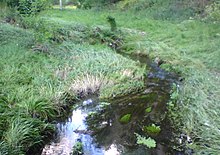1997 Spring Creek flood
 Spring Creek during minor flooding in 2007 | |
| Cause | Heavy rains |
|---|---|
| Meteorological history | |
| Duration | July 27–28, 1997 |
| Flood | |
| Maximum rainfall | 14.5 in (370 mm), western Fort Collins, Colorado, US |
| Overall effects | |
| Fatalities | 5 |
| Injuries | 62 |
| Damage | >$250 million |
| Areas affected | Spring Creek, Fort Collins, Colorado |
| Houses destroyed | 200[1] |
In a two-day period on July 27–28, 1997, heavy rainfall caused an overflow of the
Background
Spring Creek is a 12.7-mile-long (20.4 km)
Meteorological synopsis
On July 27, a
Impact
Most of the rain fell across western portions of Fort Collins, near Spring Creek.
Aftermath
After the flood, 400 people were rescued.[20] A documentary film was made detailing the flood and the reconstruction after the disaster.[21][22] A high water marker was erected at Colorado State University designating the water level during the flood at Spring Creek, and flood-height poles were also built.[9][14] Following the flood, flood management projects and further mitigation measures were enacted, which cost $50 million.[7] A system used for flood warnings was also initiated, which was supported by the Federal Emergency Management Agency.[3] New structures were also built in Fort Collins as improvements, which included channels and retaining walls being situated.[3] The Community Collaborative Rain, Hail and Snow Network was also created as a result of the floods, first beginning in Larimer County in 1998.[23] Events were also set up to commemorate 20 years after the disaster in 2017.[24]
References
- ^ a b c d e "20 Years Later, Fort Collins Better Prepared For Flash Floods". KUNC. July 27, 2017. Archived from the original on January 17, 2024. Retrieved January 17, 2024.
- ^ "Spring Creek". Geographic Names Information System. United States Geological Survey, United States Department of the Interior. Retrieved February 22, 2024.
- ^ Colorado Encyclopedia. Archivedfrom the original on May 19, 2023. Retrieved January 22, 2024.
- ^ "Spring Creek". City of Fort Collins. Archived from the original on January 23, 2024. Retrieved January 23, 2024.
- ^ ISSN 0022-1694. Archived from the original on May 17, 2012. Retrieved January 24, 2024 – via ScienceDirect.
- ^ The Rocky Mountain Collegian. Archivedfrom the original on May 19, 2023. Retrieved January 24, 2024.
- ^ FEMA. February 11, 2021. Archivedfrom the original on October 18, 2023. Retrieved January 24, 2024.
- ISBN 9780520257030 – via Google Books.
- ^ a b c d e Manning, Anne (July 26, 2017). "A perfect storm, and a 500-year flood". Colorado State University. Archived from the original on June 6, 2023. Retrieved January 24, 2024.
- ^ a b c d McKee, Thomas; Doesken, Nolan J. (January 1, 2015). "Analysis of rainfall for the July 28, 1997 flood in Fort Collins, Colorado, An". Department of Atmospheric Science Colorado State University. Archived from the original on January 24, 2024. Retrieved January 24, 2024.
- ^ ISSN 0003-0007.

- ^ a b "1997 Spring Creek Flood". Fort Collins History Connection. Archived from the original on January 17, 2024. Retrieved January 17, 2024.
- ^ a b Young, Rich (July 28, 2022). "Spring Creek Flood 25 years ago led to a national precipitation network, infrastructure upgrades". Colorado State University. Archived from the original on June 3, 2023. Retrieved January 17, 2024.
- ^ a b c Duggan, Kevin (July 20, 2017). "Duggan: The flood that shocked and traumatized Fort Collins". Fort Collins Coloradoan. Retrieved January 17, 2024.
- from the original on January 17, 2024. Retrieved January 17, 2024.
- ^ "Victims remembered on 10th anniversary of Fort Collins Flood". Vail Daily. July 29, 2007. Archived from the original on January 23, 2024. Retrieved January 23, 2024.
- CBS Colorado. July 30, 2017. Archivedfrom the original on January 17, 2024. Retrieved January 17, 2024.
- ^ "5 die as record rains flood Fort Collins". Deseret News. July 29, 1997. Archived from the original on January 22, 2024. Retrieved January 22, 2024.
- ISSN 0003-0007.
- ^ "Follow the Flood Event". City of Fort Collins. Retrieved January 24, 2024.
- ^ Dodge, Jeff (March 28, 2020). "Reel CSU Stories: The campus flood of 1997". Colorado State University. Archived from the original on June 3, 2023. Retrieved January 22, 2024.
- ^ Manning, Anne (July 26, 2017). "Record rain, record flood: A timeline of the July 1997 flood". Colorado State University. Archived from the original on February 5, 2023. Retrieved January 22, 2024.
- ^ Duggan, Kevin (July 20, 2017). "Spring Creek Flood launched international weather-watching network". Fort Collins Coloradoan. Retrieved January 24, 2024.
- KUSA. Retrieved January 25, 2024.
